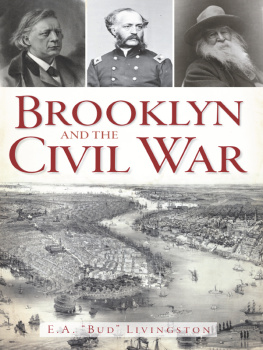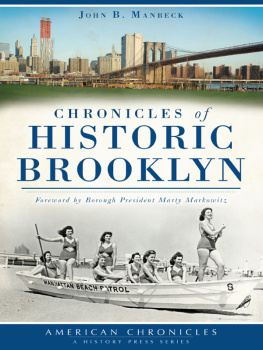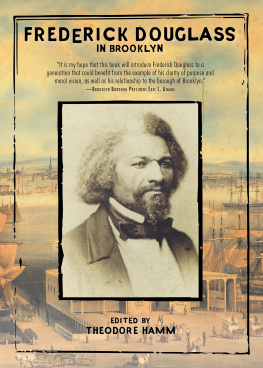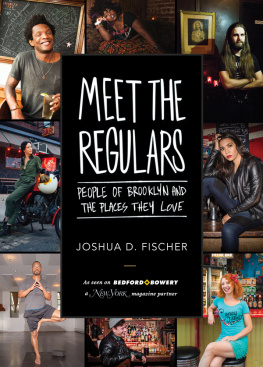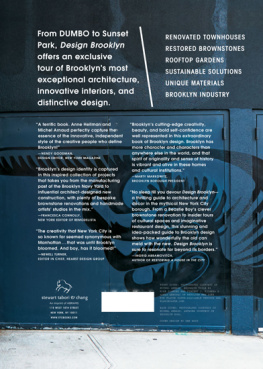
Published by The History Press
Charleston, SC 29403
www.historypress.net
Copyright 2012 by E.A. Livingston
All rights reserved
All images courtesy of the Library of Congress.
First published 2012
e-book edition 2012
ISBN 978.1.61423.447.0
Library of Congress CIP data applied for.
Notice: The information in this book is true and complete to the best of our knowledge. It is offered without guarantee on the part of the author or The History Press. The author and The History Press disclaim all liability in connection with the use of this book.
All rights reserved. No part of this book may be reproduced or transmitted in any form whatsoever without prior written permission from the publisher except in the case of brief quotations embodied in critical articles and reviews.
Contents
Acknowledgements
I could say that I almost gave up on this entire project. This, however, would be untrue. I did give up. And while discussing the difficulties of finding information about Civil War Brooklyn, I related my tale to Marie Reno and Steve Jaffe, members of the Civil War Round Table of New York. They talked me into working at the task in a different manner. Without their encouragement, I never would have produced this book.
Both Marie and Judy Hallock helped enormously, reading, editing and making suggestions as to how to better the manuscript, and the late Dr. Frank Merli of the history department of Queens College is mostly responsible for whatever decent writing you will find here.
Burt and Dana Levine allowed me to use their Apple computer for my masters degree thesis, and this book is just an outgrowth of that paper. Others who helped in major or minor ways were Pat Falci; Malcolm and Cherokee Stock; Terry Hunt; Clare Lamers (the Brooklyn Historical Societys quintessential librarian); my sister Shari; my daughter Julie; her husband, Peter Gordon (my computer expert who continually got me out of tangled messes on my word processor); my son Daniel; his wife, Sandra; Joan Maynard; Pat and Dick Merrill; Ari and Olive Hoogenboom; Paul Nergelovic of the West Point library; James O. Hall; Edith Bartley of the Plymouth Church; Dr. Edwin Redkey; Dr. William Seraille; Dr. Robert Swan; Ben Maryniak; Joe Geden; Lex Paradis; John Willetts; the late Frank Raymond; Jack Mulloy; Nancy Moore; and Ron Nelson. Nancy and Ron, thousands of miles away, gave me indescribable encouragement. Ernie and Hedwig Ries translated antebellum German church records, and Arthur Konop, the archivist at St. Francis College, taught me that all of Brooklyn was Kings County but all of Kings County was not Brooklyn. Fred Halla, of the Brooklyn Heights Weekly Record, was kind enough to publish my work for the general public. Thank you to Dozier Hasty.
And a very special thanks goes to Robert Creamer, one of the countrys foremost sportswriters. He mentioned me in his book Baseball in 41, and it would be churlish of me not to mention him here.
And thanks to my dear, dear friend Doris Lehman, who inspired me to forge ahead with this new edition. She is just incredible.
Geography
Brooklyn, New York: land area eighty-one square miles; located at seventy-three degrees fifty-eight minutes west longitude and forty degrees forty minutes north latitude; highest elevation: Green-Wood Cemetery, 216 feet; lowest elevation: sea level; widest point: nine and a half miles between the East River and the Queens County border; greatest length: eleven and a half miles from Greenpoint, in the north, to Coney Island in the south. Approximately sixty-five miles of natural shoreline. Part of the Atlantic Coastal Plain, a geological region that stretches from north of New York City to Florida; its features include a rolling plain of the Pleistocene Age, a terminal moraine and a broad outwash plain created by a retreating glacier thirteen thousand years ago.
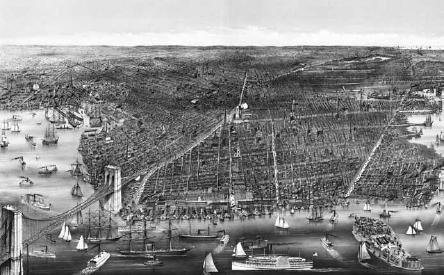
The city of Brooklyn. Produced for Currier and Ives, circa 1879.
Introduction
On the very first day of the year 1898, the city of Brooklyn ceased to exist.and a world-famous accent, no mean feats. Despite its subsumption, it remained in many ways a separate entity. Many natives respond Brooklyn and not New York when asked about their origins.
During its heyday, the city enjoyed a special reputation. On the eve of the Civil War, Brooklyns population exceeded that of every other American city except Philadelphia and New York, and its waterfront facilities transshipped most of Americas western grain exports. While the Brooklyn Navy Yard employed over five thousand workers daily, another shipyard, the Continental Iron Works, built a unique vessel that altered naval warfare forever. Adopted son Walt Whitman became one of Americas best-known and most controversial poets, and George W. Goethals, future builder of the Panama Canal, attended public school near his home in Brooklyn Heights. Elias P. Howe Jr. sold sewing machines from his house, having obtained the first American patent on that invention, and Peter Cooper, one day to lend his name to Cooper Union, ran a glue factory near the Maspeth border. German immigrant Samuel Liebmann made lager beer in a factory near Bushwick Avenue and called his product Rheingold, while two of the countrys major pharmaceutical companies, Squibb and Pfizer, both begun in Brooklyn, thrived during the Civil War. Local manufacturers made an incredible variety of products ranging from macaroni to oilcloth, including the first American-made, commercially produced chinaware. The Greenpoint neighborhood provided jobs for 35 percent of its working population in the shipbuilding trade, and the citys Dime Savings Bank may have started the bank-by-mail system by dealing with peripatetic soldiers.
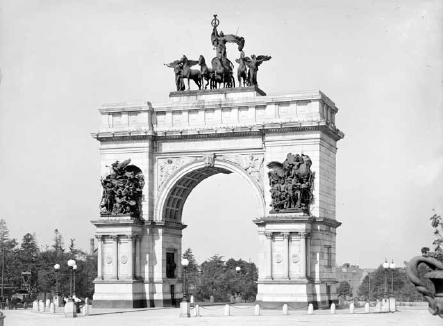
Soldiers and Sailors Memorial Arch in Brooklyn.
The citys major theater featured leading performers of the day, including John Wilkes Booth, who played there twice in 1863. Brooklyns most famous house of worship, the Plymouth Church, led by the countrys most controversial clergyman, Henry Ward Beecher, gained the attention of potential presidential candidate Abraham Lincoln when he visited there in 1860. Brooklyn sported four well-known and excellent base ball teams, one of which made the very first base ball tour, playing in western New York State, Philadelphia and Boston, giving our future national pastime its greatest boost ever.
These aforementioned surprises form a foundation for Brooklyns claim to greatness. It might have been famous but for one insuperable impediment: its proximity to New York City.
General Description
Swelled by the arrival of Irish and German immigrants and a steady flow of middle-class families from overcrowded Manhattan, Brooklyns ever-increasing population placed it seventh among American cities in 1854. On January 1, 1855, however, with the annexation of the city of Williamsburgh (50,000) and the town of Bushwick (7,000), Brooklyn claimed more than 279,000 residents, making it the third-largest city in the United States.
Brooklyns name, an Anglicized version of Breuckelen, one of the original towns of Kings County,
By 1860, Brooklyn had become one of Americas great manufacturing centers and claimed a complex and varied industrial base. Its factories wended their way along the shoreline from Red Hook in the south to Williamsburg
Next page
